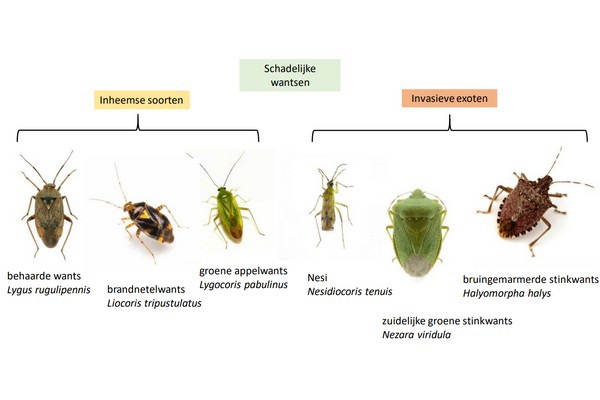Harmful bugs are appearing with increasing frequency in greenhouse horticulture due to the reduced use of broad-spectrum plant protection products. Most cases involve infestations of the hairy bug Lygus rugulipennis, the nettle bug Liocoris tripustulatus, and the green apple bug Lygocoris pabulinus (Figure 1.1).
According to researchers from WUR, the biggest problems occur in chrysanthemum, gerbera, sweet pepper, cucumber, and aubergine crops. In peppers and aubergines, these bugs can establish themselves and build up a population. In chrysanthemums, this is still unclear. The bugs feed on plant parts, causing flower deformities, flower abortion, and sucking damage to fruits. Chemical control of these bugs often comes too late and is also undesirable due to the disruption of the overall biological control system. Researchers at WUR explain more.
Figure 1.1.
In addition to native harmful bugs, problems have arisen with the establishment of exotic bugs. In tomatoes, the Mediterranean bug Nesidiocoris tenuis (also known as Nesi) causes many issues. Chemical control is extremely difficult because these treatments also strongly affect the predatory bug Macrolophus pygmaeus, leading to other pests, such as whitefly and Tuta absoluta, getting out of control. Another increasingly common exotic pest is the southern green shield bug Nezara viridula. Most reports of problems come from pepper cultivation, where these bugs quickly cause damage due to their preference for fruits. This bug is also difficult to control selectively because of the side effects of pesticides on beneficial predatory bugs like Orius and Macrolophus. Besides N. viridula, the brown marmorated shield bug Halyomorpha halys is also advancing in Europe. In Italy, this bug is already causing significant damage in horticulture, including tunnel-grown vegetables. In the Netherlands, this bug was first found in Limburg in 2020. Due to climate change, this species could also become established in northern Europe.
Harmful bugs
With the increase in native and exotic harmful bugs (Figure 1.1) and the reduced scope for chemical control, there is a need to develop alternative non-chemical methods of control. Within the PPP "Functional Biodiversity in and around the greenhouse" (TKI-LWV 19162), four years of research were conducted on the control of two species of harmful bugs: the hairy bug L. rugulipennis and the southern green shield bug N. viridula.
New non-chemical ways
The aim of this project was to develop new non-chemical methods of control for both pest bugs. For the hairy bug, the research focused on predicting fly-ins, manipulating the behavior of fly-in bugs with attractants and repellents (push-pull), and deploying selective biological agents based on entomopathogenic fungi. Research on the southern green shield bug focused on improving signaling with decoy plants and pheromone traps, as well as biological control with predatory bugs, parasitic wasps, and entomopathogenic fungi.
This WUR report presents the results of these studies.
